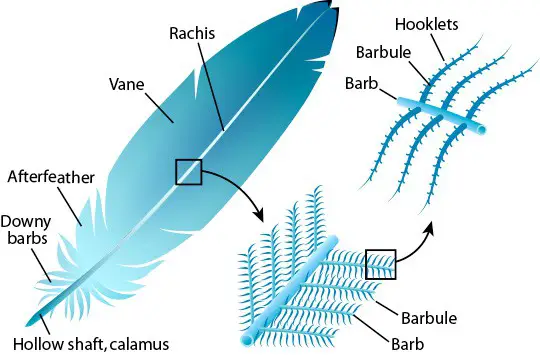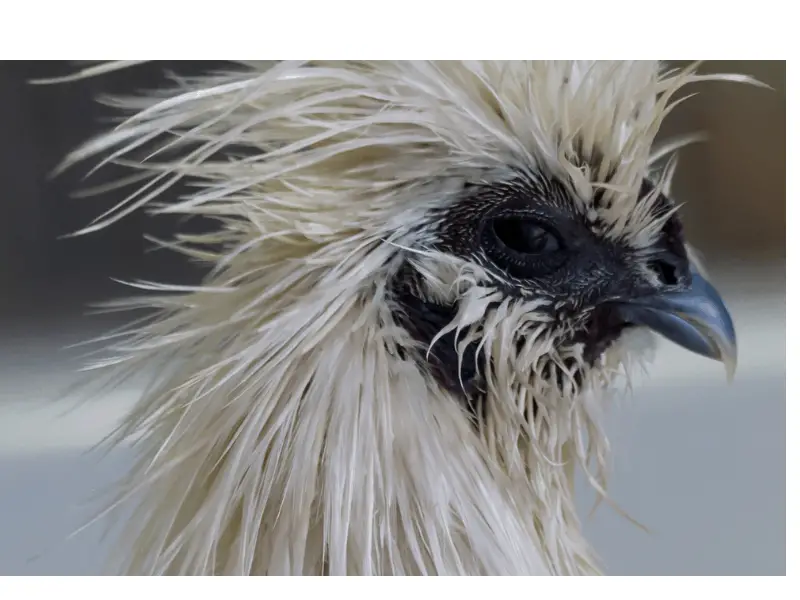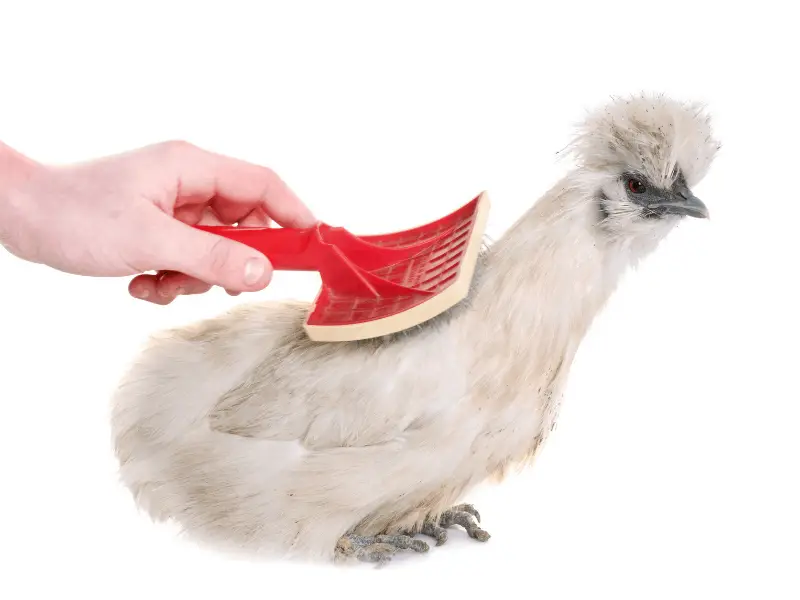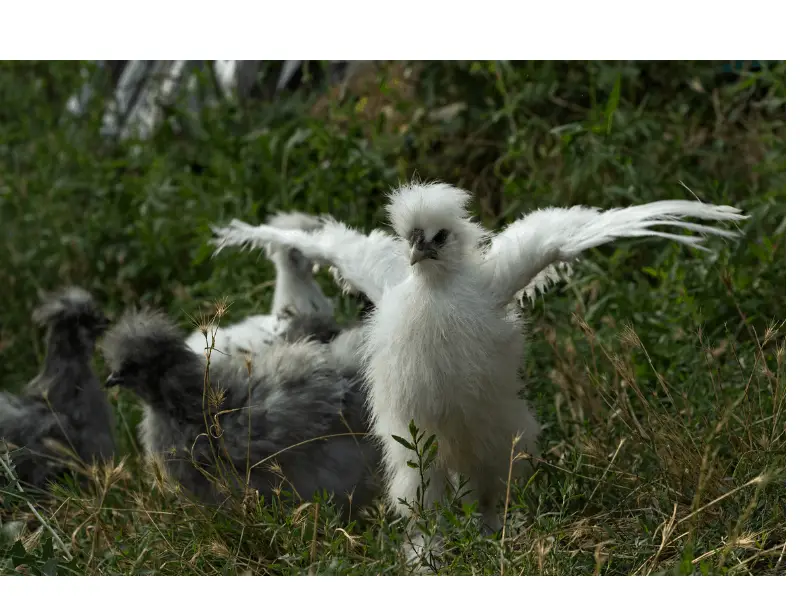Silkie chickens are known for their soft fluffy feathers and docile personalities. This makes them a very popular choice as backyard pets. Not only are they incredibly cute, but you will rarely ever have to go fetch them from your neighbor’s backyard due to them being unable to fly.
Silkie chickens are completely flightless. Due to the fact that their feathers do not have barbicels (microscopic structures that keep feathers smooth and water-tight), their feathers are wispy and soft. This makes them unable to use their wings to fly.
We have a closer look at shy exactly silkie chickens are unable to fly and what you need to consider when keeping them in your backyard.
Silkie Chicken Feathers vs. Regular Chicken Feathers?
If you hold a silkie chicken feather next to a regular chicken feather, the difference is rather obvious. The regular feather is smooth. It typically has a thick shaft down the center of the feather with thick hairs growing on either side of the shaft. Compare this to a silkie chicken feather that has soft wispy ‘hairs’ which do not ‘stick’ to each other growing on either side of a shaft.
Having closer look, as in, microscopically close, regular chicken feathers have microscopic ‘hooks’ called barbicels that help each individual barbule stick to the one next to it, creating a smooth, waterproof, windproof surface. Silkie chicken feathers completely lack these barbicels, causing the individual barbules to fray separately and the feather to have a fuzzy appearance.

Interestingly, regular chicken undercoat or down has a similar appearance, lacking barbicels, but having shorter shafts. So, in essence, Silkie chickens have modified undercoats or down covering their entire body and lack the waterproof, windproof feathers that regular chickens (and most birds for that matter) have. This is also the reason why silkie chickens are completely unable to fly.

The Implications of Having Fluffy Feathers
Not only can silkies not use their feathers to gain any sort of height while flapping their wings, but they are also completely unable to swim. Their feather lacks any sort of air or water tightness. If a silkie chicken gets wet, they become completely soaked as their feathers are unable to repel water the way normal feathers can. This is extremely important to know when looking after silkies. They do not cope well with rain or muddy conditions at all.
Because silkies are unable to fly, they are very vulnerable to predators. A silkie chicken’s only defense against predators is either to fight or to try and run away. Due to silkie’s docile nature, most will not attempt to fight, and since a silkie chicken’s fastest running speed is 6,5 mph, the odds are against them if we compare it to the running speed of the most common land predators such as a fox, which clocks in at 31 mph.
For this reason, it is extremely important to have a lockable coop to keep your backyard silkies safe, especially between sunset and sunrise.
Needless to say, silkies are also completely unable to swim. If a silkie finds themself in water, they will quickly become soaked and their water-logged feathers will start to drag them down. It is worth a mention to know that birds have large air-filled sacks inside their bodies as well as light, spongy bones that will help them stay afloat in water, but the bottom line is, if a silkie ends up in a body of water, it needs to get out of there within a matter of seconds.

Silkies can however be bathed in a shallow bucket. Silkie feathers tend to collect dirt and mud rather quickly, so bathing your silkie now and then is completely fine. To dry the silkie off, simply wrap it in a towel and place it in a warm area for some time, or, if t is sunny outside, you can simply let them sun-dry.

How High Can Silkie Chickens Jump? How High does my fencing need to be?
Silkies can jump around 10 inches high to a perch. Big jumps will usually be preceded with a lot of flapping which is rather amusing to see. Silkies are seemingly unaware of the fact that they can’t fly and will dramatically clap their wings as if to take off before jumping onto a higher area.
12 inches is the safe limit of a silkie’s vertical ability, but be aware, they are pretty smart and can figure out how to use multiple steps to gain height.
In terms of fencing them in, regular backyard fencing is usually more than high enough to contain our silkies but be aware of possible objects close to the fence that they can use as steps.

Do Silkie Chickens Need a Perch? And do Silkies Like to Roost?
Silkie chickens prefer to sleep off the ground and will make use of a roosting area if available. They will often sleep on as high a perch they can get to. This adds an element of feeling secure.
It’s a great idea to build a ramp up to a perch off the ground for your silkies to sleep on at night. Just be sure to check that the perch is round and smooth and preferably not less than 2 inches in diameter. Silkies do not wrap their feet around a perch like other birds typically do and therefore, they prefer to ha a slightly bigger perch to comfortably sit on.
This is especially true if you keep your silkies with other chickens who roost up high at night. You can build a ladder to help them reach a higher perch to roost on as well. Hay bales are another good option to put in the coop to help silkies reach higher perches at nighttime.
Now and then you may come across a silkie that does not use the roost and will sleep on the floor, but they are few and far between and most of them will, once they have learned how to, utilize steps and ladders to roost anywhere from 6 to 8 inches off the ground.
In summary
Silkies are at most capable of a somewhat controlled fall from a height, but their wings are incredibly poor at breaking their fall. For this reason, never drop a silkie from a height. Put them down slowly.
You can build steps and ladders to help them reach perches of about 6-8 inches high. They do prefer to use perches off the ground during nighttime.
Silkies are easy to contain in a backyard and do not need unusually high fencing. Just make sure there are no objects close to the fence line that they can possibly use as steps to get to the top of the fencing.
The fact that they are completely flightless makes them extremely vulnerable to predators. The problem with keeping silkies in your back yard will not be to keep the silkies inside, but much rather keep the predators outside.
Due to their feather structure, silkies can not swim and do not cope well with getting wet. Their feathers have near-zero water-repelling benefits and they become completely soaked in rain. Make sure your silkies have cover when it rains and keeps them out of the mud.
Silkie’s unique feathers are both a blessing and a curse. It makes them incredibly cute and fluffy, but on the other end of the spectrum makes them vulnerable to predators and unable to cope with wet conditions. Luckily, all the cons can easily be managed in a backyard setup by building ladders to perches and making sure they have a roofed area and secure coop to sleep in.
